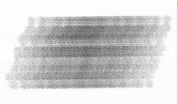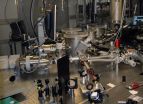Revolutionary discovery could help tackle skin and heart conditions
2015-05-13
(Press-News.org) Scientists at The University of Manchester have made an important discovery about how certain cells stick to each other to form tissue.
The team from the Faculty of Life Sciences studied how cells in the skin and heart are bound together through structures called desmosomes. They wanted to understand how these junctions between the cells in the tissue are so strong.
Desmosomes are specialised for strong adhesion. They bind the tissue cells together to resist the rigours of everyday life and their failure can result in diseases of the skin and heart, including sudden cardiac death.
Contrary to popular scientific thinking the researchers revealed a revolutionary finding - that the desmosomes achieve their strength through flexibility rather than rigidity. Their findings have been published in the journal PNAS.
Dr Lydia Tabernero explains the results: "Scientists had always thought the reason for these incredibly strong connections was because the molecules were very rigid and structured as they are in other, weaker intercellular junctions. However, when we isolated desmosome molecules and characterised them we found that they are actually much more flexible than those of the other junctions - the total opposite to what people had thought!"
Desmosomes contain proteins that have extra cellular regions. These form the adhesion that bind the cells to each other and prevent them from separating.
To study their structure Dr Tabernero and her team extracted the proteins and accessed the molecules. Using x-ray scattering, biophysical and computational analyses they were able to build a model of what the molecule looks like and reveal its flexible nature. The molecules are much more ordered than in other intercellular junctions and the ordering is crucial for strong adhesion. Curiously, it is this flexibility that enables them to become ordered.
Dr Tabernero comments: "What is really fascinating about desmosomes is that they become weaker during wound healing and embryonic development, and this weakening is necessary to allow cells to move. In contrast, desmosomes are very strong in adult tissues, particularly in skin and heart. It has been incredibly difficult to work out how they do that but our findings shed new light on this."
She continues: "Conducting this research has been very challenging, but understanding the result was even harder as it went against everything we were expecting. Seeing the flexibility was a big surprise and we had to retest the molecules using different techniques to confirm our findings."
Professor David Garrod has studied desmosomes for decades. He says there are exciting implications for these findings: "This is the first time that any structural information has been reported for desmosome adhesion. Understanding these cell junctions will be important for future biotechnology applications. We also hope our research will contribute to studies into wound healing, cancer and embryonic development."
INFORMATION:
[Attachments] See images for this press release:

ELSE PRESS RELEASES FROM THIS DATE:
2015-05-13
A part of the performance degradation mechanism of the advanced, electrodeless, helicon plasma thruster with a magnetic nozzle, has been revealed by the research group of Dr. Kazunori Takahashi and Prof. Akira Ando at Tohoku University's Department of Electrical Engineering.
An electric propulsion device is a main engine, and a key piece of technology for space development and exploration. Charged particles are produced by electric discharge and accelerated, i.e. momentum is transferred to them via electromagnetic fields. The thrust force is equivalent to the momentum ...
2015-05-13
Digital signatures are mechanisms for authenticating the validity or authorship of a certain digital message and they aim to be digital counterparts to real (or analog) signatures. The concept was introduced by Diffie and Hellman in 1976. Notice that, when certified, digital signatures have the same legal power as traditional signatures.
With the advent of quantum computation new threats to security became a near future reality and all known digital signatures schemes are vulnerable, compromising fundamental properties of signature schemes: authenticity and authorship ...
2015-05-13
Chicago (13 May, 2015)- In the latest issue of the Bulletin of Atomic Scientists, published by SAGE, experts from the United States, Russia, and China present global perspectives on ambitious nuclear modernization programs that the world's nuclear-armed countries have begun.
In the latest edition of the Bulletin's Global Forum, Georgetown University professor Matthew Kroenig argues that:
"Failure to modernize would not contribute to disarmament - but more than that, it would be irresponsible. A crippled US nuclear force would embolden enemies, frighten allies, generate ...
2015-05-13
The recombination of electron shells in molecules, taking just a few dozen attoseconds (a billionth of a billionth of a second), can now be viewed "live," thanks to a new method developed by MIPT researchers and their colleagues from Denmark, Japan and Switzerland. An article detailing the results of their study has been published in the journal Nature Communications.
In recent years, scientists have learned how to study ultrafast processes taking place at the atomic and molecular levels, and research in this field is expected to yield some very important results. In ...
2015-05-13
This news release is available in German. Chloroplasts are the solar cells of plants and green algae. In a process called photosynthesis, light energy is used to produce biochemical energy and the oxygen we breathe. Thus, photosynthesis is one of the most important biological processes on the planet. A central part of photosynthesis takes place in a specialized structure within chloroplasts, the thylakoid membrane system. Despite its apparent important function, until now it was not clear how this specialized internal membrane system is actually formed. In a collaborative ...
2015-05-13
Amsterdam, May 13, 2015 - A new family of molecules that kill cancer cells and protect healthy cells could be used to treat a number of different cancers, including cervical, breast, ovarian and lung cancers. Research published in EBioMedicine shows that as well as targeting and killing cancer cells, the molecules generate a protective effect against toxic chemicals in healthy cells.
Cells can become cancerous when their DNA is damaged. Many different things can cause DNA damage, including smoking, chemicals and radiation; understanding exactly what happens at the point ...
2015-05-13
London/Zurich, May 13, 2015: Children in European countries tend to report higher levels of satisfaction with their friendships while children in African countries tend to be happier with their school lives. Children in northern European countries are particularly dissatisfied with their appearance and self-confidence. Most of the 50,000 children in the 15 countries rated their satisfaction with life as a whole (on a scale from zero to ten) positively, but the percentage of children with very high well-being (10 out of 10) varied from around 78% in Turkey and 77% in Romania ...
2015-05-13
The time needed to genetically sequence the bacteria causing tuberculosis (Mtb) from patient samples has been reduced from weeks to days using a new technique developed by a UCL-led team. This could help health service providers to better treat disease, control transmission of this infection, and monitor outbreaks.
Tuberculosis (TB) disease rates in some parts of London are as high as in Sub-Saharan Africa, and drug-resistant strains are becoming increasingly common. These require specific treatments, and if doctors know that a bug is resistant they can start therapy ...
2015-05-12
A new study published today in the journal Addiction has compiled the best, most up-to-date evidence on addictive disorders globally. It shows that almost 5% of the world's adult population (240 million people) have an alcohol use disorder and more than 20% (1 billion people) smoke tobacco. Getting good data on other drugs such as heroin and cannabis is much more difficult but for comparison the number of people injecting drugs is estimated at around 15 million worldwide.
The "Global Statistics on Addictive Behaviours: 2014 Status Report" goes further in showing that ...
2015-05-12
Roughly 1 in 4 women having breast conserving surgery (BCS) return to the surgical suite for further resection because of cancerous tissue left behind due to unclear margins. Investigators at the Optics in Medicine Lab at Dartmouth's Thayer School of Engineering and Norris Cotton Cancer Center, led by Brian W. Pogue, PhD and Keith Paulsen PhD, with first author and PhD candidate David M. McClatchy III, devised a novel approach to perform near infrared (NIR) optical measurements of resected breast tissue after the margins have had their traditional marking by the surgeon ...
LAST 30 PRESS RELEASES:
[Press-News.org] Revolutionary discovery could help tackle skin and heart conditions

